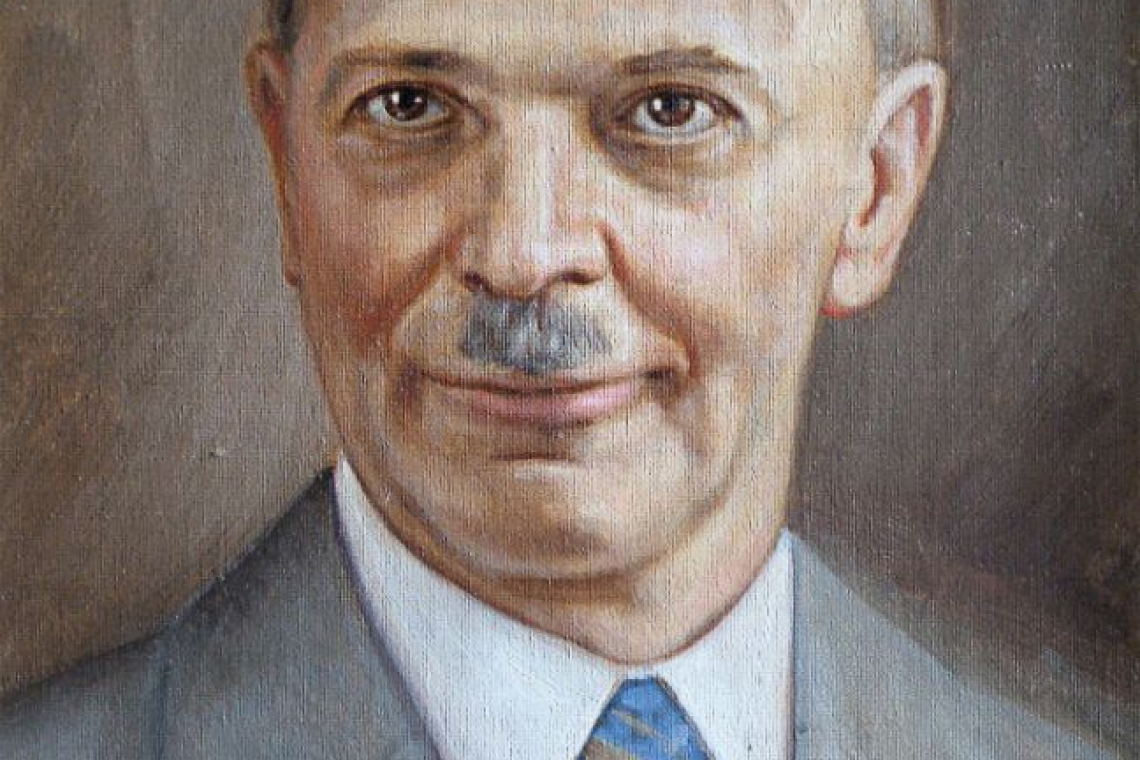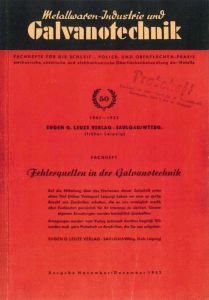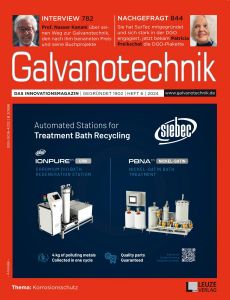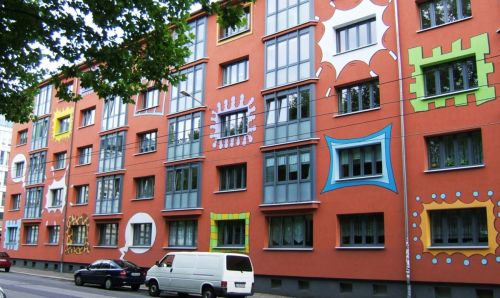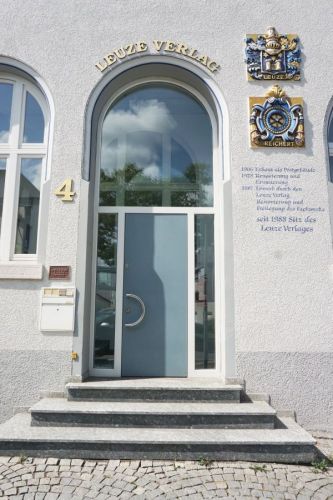Eugen G. Leuze would have been 150 years old this August. Who was the man who, in 1902, laid the foundations for the publishing industry heavyweight Galvanotechnik and Leuze Verlag? A look back reveals a man who fulfilled a dream as a publishing bookseller: he created his own electroplating medium. It has now accompanied German industrial development in the field of electroplating for well over 100 years, always keeping abreast of the latest technological developments
In 1874, Reutlingen was a vibrant, industrial city in Württemberg. The textile industry dominated the cityscape, and commercial activity was characterized by looms and early machinery. The streets were bustling with activity: workers flocked to the factories, traders offered their wares for sale and horse-drawn carriages rattled over the cobblestones. The city was experiencing an economic boom in the early years of the German Empire.
Eugen Georg Leuze was born into this world on August 8, 1874. His parents owned a department store, but Eugen was orphaned at an early age. Undeterred, however, he pursued his dream of founding his own publishing house. To achieve this goal, he moved to Leipzig, which was already considered the "publishing city" and center of the German book trade at the time. The move meant a major linguistic and cultural change, because while Reutlingen only had around 21,000 inhabitants in 1900, Leipzig had over 450,000. The city was characterized by lively trade fair activities, cultural wealth and a dynamic economic upswing, which made it an ideal place for a new start. The German Football Association (DFB) was also founded in Leipzig that year. It was the founding era.
Metal trades join forces to create electroplating technology
1902 was the year. At the age of 28, Eugen Georg Leuze published his first magazine: "Gürtler-, Bijouterie- und Broncewaren-Industrie". "Bijouterie" comes from the French and refers to the art of jewelry making; the belt maker, known today as a metalworker, shapes and works metal. The somewhat unwieldy title reflects the diversity of the metalworking trades, which produced both functional and decorative products. These trades were highly respected and relevant in industrial and artisan circles at the turn of the century. The trade journal served as a platform to disseminate knowledge and news about techniques, materials and market trends in these areas.
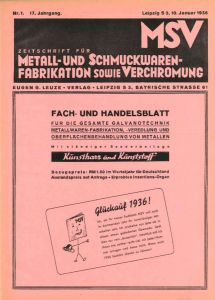 Layout of the magazine in January 1936, when it was called MSV - Metall- und Schmuckwaren-Fabrikation sowie Verchromung
Layout of the magazine in January 1936, when it was called MSV - Metall- und Schmuckwaren-Fabrikation sowie Verchromung
The early history of the magazine shows Leuze's foresight and entrepreneurial courage. Just four years after it was founded, the editorial focus changed significantly, which was also reflected in the subtitle: "Journal for all galvanic, chemical and mechanical metal treatment and processing". Despite the early sale of the magazine to the publishing house Ernst Steiger in 1912, Leuze founded another publication in 1920 called "Zeitschrift für Metall- und Schmuckwaren-Fabrikation sowie Verchromung", or "MSV" for short. These two magazines became known as the "red" and "blue" magazines due to their different cover colors.
Magazine becomes a forum for entrepreneurs
A look at the Leuze online archive illustrates the timeless character of the MSV from the 1930s and 1940s. It was full of reports on new technical developments, field reports, patents and even discussions, the likes of which can only be found on the Internet today. While nowadays half-knowledge is spread anonymously, back then Dr. Max Schlötter, among others, personally participated in the technical discourse. The column "From practice - for practice", which is still very popular today, began in those days, namely in May 1935. The first two articles in this issue were entitled "Solubility of anodes" and "Small hints for chrome plating". It is also worth noting that the otherwise very text-heavy newspaper was embellished with a few caricatures. In 1939, the first MSV Yearbook of Electroplating was published (today's Jahrbuch Oberflächentechnik). Originally in DIN-A6 format, it provided an overview of sources of error in electroplating and how to rectify them, as well as information on new processes such as hard chrome plating. Eugen Georg Leuze found happiness not only professionally, but also privately. He married Gertrud, who later came from West Berlin. The marriage produced son Heinz and daughter Senta.
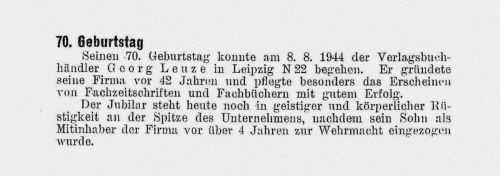 A birthday greeting for Eugen G. Leuze's 70th birthday in 1944. The publishing house had been bombed out shortly beforehand
A birthday greeting for Eugen G. Leuze's 70th birthday in 1944. The publishing house had been bombed out shortly beforehand
War and defeat end the Leipzig era
During the Second World War, the Reich Press Chamber ordered that only one specialist journal could be published in each specialist area. This led to the merger of the "red" and "blue" journals under the title "Metallwaren-Industrie und Galvanotechnik MSV" on April 10, 1943. Despite the destruction of the Leipzig publishing building by bombing on December 4, 1943, the journal was published regularly until the end of the war. The publishing offices were initially moved from Bayrische Straße 61 to Dufourstraße 36 and from September 1944 to Menckestraße 14.
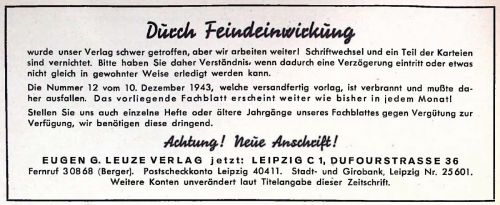 Fateful day December 4, 1943: Leuze Verlag is bombed out
Fateful day December 4, 1943: Leuze Verlag is bombed out
Heinz Leuze had already taken over the editorship of the magazine in the 1930s. After he was called up and sent to Russia, his father took over this position again on an interim basis. Eugen Georg Leuze died in Leipzig on April 3, 1946 at the age of 71, while his son Heinz did not return from Russian captivity until 1947.
A new start in the West
He was faced with the challenge of re-establishing the publishing house in the post-war period. As no publishing license was granted in the Soviet-occupied zone of Germany, Heinz Leuze decided to relocate the publishing house to the West. In the spring of 1952, he found a new home for Leuze Verlag in Saulgau, Württemberg, which he completely rebuilt together with his wife Steffi. It was pure coincidence that the new location was only an hour's drive from Reutlingen. The decision to move to Saulgau was made because he was offered a position by Haug-Verlag - a medical publishing house.
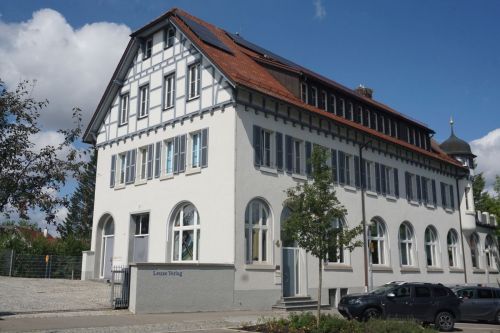 Today, Leuze Verlag is based in Bad Saulgau, Württemberg. The building on Karlstraße was occupied in 1988
Today, Leuze Verlag is based in Bad Saulgau, Württemberg. The building on Karlstraße was occupied in 1988
With great commitment and under difficult conditions, Heinz Leuze succeeded in reviving the magazine "Galvanotechnik". The first issue after the war was published in December 1952, and the magazine once again took its place in the professional world. Initially, it continued to bear the old title "Metallwaren-Industrie und Galvanotechnik", but this was changed in 1959 to "Galvanotechnik", the title still used today. Under Heinz Leuze's management, the publishing house developed into an important provider of technical specialist literature, particularly in the field of electroplating and chemical surface treatment of metals.
Eugen G. Leuze leaves a lasting legacy
Eugen Georg Leuze's visionary work and his contribution to the world of specialist publishing left a lasting legacy. "Galvanotechnik" remained an indispensable medium for professionals worldwide and reflected the continuous progress and innovations in metalworking. Despite personal and professional challenges, Leuze Verlag was able to survive for generations and establish itself as the leading address for electroplating publications.
Acknowledgments
Some images and additional information are from the Museum of Electroplating in Leipzig and were provided by Ulrich Viehweger and Thilo von Vopelius.
Pictures in the article: Archive, Museum of Electroplating




